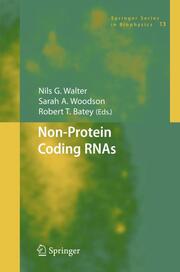Detailansicht
Non-Protein Coding RNAs
Springer Series in Biophysics 13
ISBN/EAN: 9783642089800
Umbreit-Nr.: 1301628
Sprache:
Englisch
Umfang: xi, 398 S.
Format in cm:
Einband:
kartoniertes Buch
Erschienen am 30.11.2010
Auflage: 1/2009
- Zusatztext
- The 2006 Nobel Prize in Physiology or Medicine was awarded to the discoverers of RNA interference, Andrew Fire and Craig Mello. This prize, which follows "RNA" Nobels for splicing and RNA catalysis, highlights just one class of recently discovered non-protein coding RNAs. Remarkably, non-coding RNAs are thought to outnumber protein coding genes in mammals by perhaps as much as four-fold. In fact, it appears that the complexity of an organism correlates with the fraction of its genome devoted to non-protein coding RNAs. Essential biological processes as diverse as cell differentiation, suppression of infecting viruses and parasitic tra- posons, higher-level organization of eukaryotic chromosomes, and gene expression are found to be largely directed by non-protein coding RNAs. Currently, bioinformatic, high-throughput sequencing, and biochemical approaches are identifying an increasing number of these RNAs. Unfortunately, our ability to characterize the molecular details of these RNAs is significantly lacking. The biophysical study of these RNAs is an emergent field that is unraveling the molecular underpinnings of how RNA fulfills its multitude of roles in sustaining cellular life. The resulting understanding of the physical and chemical processes at the molecular level is critical to our ability to harness RNA for use in biotechnology and human therapy, a prospect that has recently spawned a multi-billion dollar industry.
- Kurztext
- This book assembles chapters from experts in the Biophysics of RNA to provide a broadly accessible snapshot of the current status of this rapidly expanding field. The 2006 Nobel Prize in Physiology or Medicine was awarded to the discoverers of RNA interference, highlighting just one example of a large number of non-protein coding RNAs. Because non-protein coding RNAs outnumber protein coding genes in mammals and other higher eukaryotes, it is now thought that the complexity of organisms is correlated with the fraction of their genome that encodes non-protein coding RNAs. Essential biological processes as diverse as cell differentiation, suppression of infecting viruses and parasitic transposons, higher-level organization of eukaryotic chromosomes, and gene expression itself are found to largely be directed by non-protein coding RNAs. The biophysical study of these RNAs employs X-ray crystallography, NMR, ensemble and single molecule fluorescence spectroscopy, optical tweezers, cryo-electron microscopy, and other quantitative tools. This emerging field has begun to unravel the molecular underpinnings of how RNAs fulfill their multitude of roles in sustaining cellular life. The physical and chemical understanding of RNA biology that results from biophysical studies is critical to our ability to harness RNAs for use in biotechnology and human therapy, a prospect that has recently spawned a multi-billion dollar industry.
